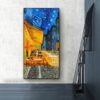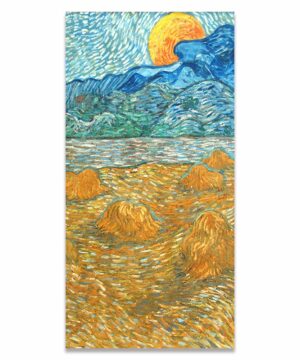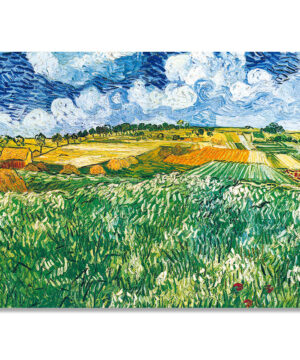Vincent van Gogh’s paintingPainting is a fundamental form of visual art that has been practiced for thousands of years. It involves applying pigment to a surface such as canvas, paper, or a wall. Painting can be explored through various styles, techniques, and mediums, each offering unique possibilities for expression and creativity. Historical Background • Ancient Beginnings: The history of painting dates back to More “Café Terrace at Night” was created in 1888. It was one of the first scenes he painted after arriving in the French commune of Arles; and it is the first picture in which van Gogh used the background of a starry night, which he became famous for. The nocturnal background would become one of his favourite motives until his death in 1890.
Where is Vincent van Gogh’s “Café Terrace at Night” original today?
The “Café Terrace at Night” van Gogh original is located at the Kröller-Müller Museum in Otterlo, Netherlands, today. It also bears two alternative titles, which are “Café, le soir” (“Coffeehouse at Evening”) and “Café Terrace on the Place du Forum”.
What’s in it?
Van Gogh’ outdoor café picture offers a seemingly relaxed night view into a street in the commune Arles. The café terrasse Van Gogh painted to the left is countered with a brightly lit shop to the right to frame the central perspective, which pulls the viewer deep into the scene. The lines of the scene all point to the centre of the work drawingDrawing is a foundational art form that involves creating images on a surface, typically paper, using tools such as pencils, pens, and charcoal. It is a versatile medium that allows artists to express ideas, emotions, and stories through lines, shapes, and shading. Historical Background • Prehistoric Beginnings: The earliest known drawings date back to prehistoric times, with cave drawings found More the eye along the pavement as if the viewer is strolling the cobblestone road. People are sitting at Van Gogh’s terrasse café outdoors, others are strolling around, or are idly walking towards us.
The artist believed, that “… the night is more alive and more richly coloured than the day…”, as van Gogh wrote in one of his letters. These thoughts are manifested in the style he uses. The profuse yellow of the café and the store illuminate the entire picture, playing against the dark blue in the remote end of the street. Using these colours and tonesIn color theory, a tone is a version of a color created by adding gray (a mix of black and white) to the original hue. This concept is essential for artists and designers as it allows for a wide range of colors that are neither too dark nor too light, providing versatility in creating depth, mood, and harmony within a More of high contrast in his café scene, van Gogh achieved a luminous surface pulsating with an interior light. The violet-blue in the foreground of Van Gogh’s terrace at night seems almost conciliatory and appeasing in the face of the almost defiantly darkening sky.
These contrasts, the warm yellow-orange and green against the dark blue of the houses in the rear, is the most eye-catching element of the “Café Terrace at Night”. As we know from Van Gogh’s own writings, he was pleased wtih this effect: “I believe that an abundance of gashlight, which, after all, is yellow and orange, intensifies blue.” The starry sky becomes key to the structure of the whole composition. The poetic idea of the work carries the concept of double illumination – stars and the lights of the café lighten up the scene alike. Meanwhile, the scattered stars are matched with the elliptically shaped tables on the ground in Van Gogh’s café at night.
Art historians have suggested that Vincent van Gogh’s paintingPainting is a fundamental form of visual art that has been practiced for thousands of years. It involves applying pigment to a surface such as canvas, paper, or a wall. Painting can be explored through various styles, techniques, and mediums, each offering unique possibilities for expression and creativity. Historical Background • Ancient Beginnings: The history of painting dates back to More “Café Terrace at Night” is an allusion to Leonardo da Vinci’s picture “The Last Supper”. A corresponding study was submitted to the European Conference on Arts and Humanities in 2013. This thesis is based on the fact that the café scene includes one central figure with long hair, surrounded by 12 further characters and a shadowy figure disappearing through the door, who might stand for Judas. Furthermore, there is a cross shining in the background of the seated group on the café terrace and further cross-like shapes throughout Vincent van Gogh’s café paintingPainting is a fundamental form of visual art that has been practiced for thousands of years. It involves applying pigment to a surface such as canvas, paper, or a wall. Painting can be explored through various styles, techniques, and mediums, each offering unique possibilities for expression and creativity. Historical Background • Ancient Beginnings: The history of painting dates back to More.
What’s the context?
Van Gogh Facts:
The Vincent van GoghVincent van Gogh (1853 – 1890) is one of the renowned Post-Impressionist artists, best known for his striking use of colour, emphatic brushwork, and contoured forms. As a son of a pastor, the Dutch artist war brought up in a religious and cultured atmosphere. After working unsuccessfully as a clerk at a bookstore, as a salesman, and as a preacher More café scene was painted during his stay in Arles in 1888, a commune south of Paris. The artist was highly productive in this period, creating numerous drawings and paintings depicturing scenes in the commune, such as “Starry Night over the Rhone” and “Starry Night”. The expressive use of colour and bold brushstrokes characterise his paintingPainting is a fundamental form of visual art that has been practiced for thousands of years. It involves applying pigment to a surface such as canvas, paper, or a wall. Painting can be explored through various styles, techniques, and mediums, each offering unique possibilities for expression and creativity. Historical Background • Ancient Beginnings: The history of painting dates back to More style at that time. The starlight background is also used in Vincent van Gogh’s famous “Portrait of Eugène Boch”.
Due to Vincent van Gogh’s religious background, the 2013 interpretation of “Café Terrace at Night” as an allusion to “The Last Supper” has been considered as likely. Not only had his father been a pastor for a Dutch reformed church, but the artists had also unsuccessfully pursued a religious career to preach the gospel before fully devoting his life to paintingPainting is a fundamental form of visual art that has been practiced for thousands of years. It involves applying pigment to a surface such as canvas, paper, or a wall. Painting can be explored through various styles, techniques, and mediums, each offering unique possibilities for expression and creativity. Historical Background • Ancient Beginnings: The history of painting dates back to More.
Chatter and Prattle
- The artist did not sign the night café picture. However, it was described and mentioned in three of Van Gogh’s letters.
- The site presented in the picture was refurbished at the beginning 1990s including the “Van Gogh Café” in Arles to replicate the scene presented by the artist. The Van Gogh night café terrace is visited by numerous fans travelling to the south of France.
- Van Gogh was a diligent observer: The positions of the stars above the roof of the “Café Terrace at Night” are highly accurate regarding astronomical data. The constellations are depicted with such fidelity that it is possible to precisely date the creation of Van Gogh’s work to the 16th or 17th of September 1888.
- Van Gogh’s “Café Terrace at Night” has a high ranking on the list of the most reproduced artworks. It ranks second for the years 2000 to 2010, just after Vincent van Gogh’s picture “Starry Night”.
- The paintingPainting is a fundamental form of visual art that has been practiced for thousands of years. It involves applying pigment to a surface such as canvas, paper, or a wall. Painting can be explored through various styles, techniques, and mediums, each offering unique possibilities for expression and creativity. Historical Background • Ancient Beginnings: The history of painting dates back to More “Café Terrace at Night” has been featured in numerous films, such as the 1956 movie “Lust for Life” starring Kirk Douglas and the 2010 film “Vincent and the Doctor”. Furthermore, the picture plays a role in the one of the episodes of the British science fiction television series “Doctor Who”, in the 2017 film “Loving Vincent”, and the 1998 film “Ronin”.
- A few weeks after Van Gogh’s café paintingPainting is a fundamental form of visual art that has been practiced for thousands of years. It involves applying pigment to a surface such as canvas, paper, or a wall. Painting can be explored through various styles, techniques, and mediums, each offering unique possibilities for expression and creativity. Historical Background • Ancient Beginnings: The history of painting dates back to More was finished, the artist suffered a psychotic episode in which van Gogh cut off part of his ear. He went back to Paris, where he was admitted to a hospital.
Recommended Readings:
This article may contain compensated links. Please read Disclaimer for more info. As an Amazon Associate, I earn from qualifying purchases.
Ingo F. Walther et al. (2020): Van Gogh. The Complete Paintings
Vincent Van GoghVincent van Gogh (1853 – 1890) is one of the renowned Post-Impressionist artists, best known for his striking use of colour, emphatic brushwork, and contoured forms. As a son of a pastor, the Dutch artist war brought up in a religious and cultured atmosphere. After working unsuccessfully as a clerk at a bookstore, as a salesman, and as a preacher More (2020): The Letters of Vincent Van Gogh
Martin Gayford (2008): The Yellow House: Van Gogh, Gauguin, and Nine Turbulent Weeks in Provence
Steven Naifeh et al. (2012): Van Gogh: The Life (RANDOM HOUSE)
Steven Naifeh (2021): Van Gogh and the Artists He Loved












